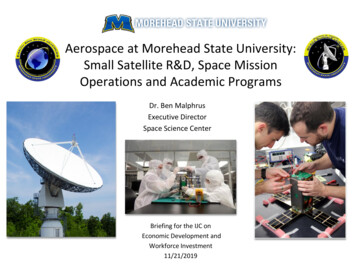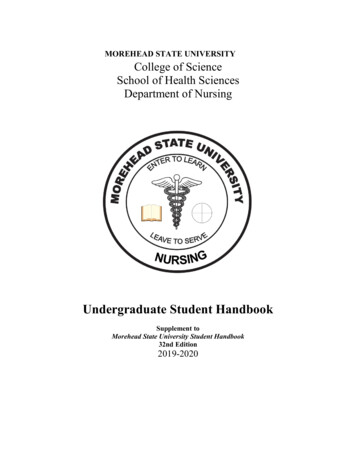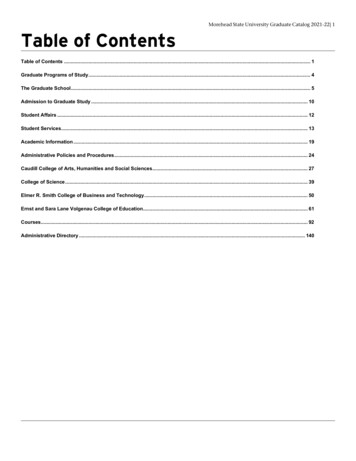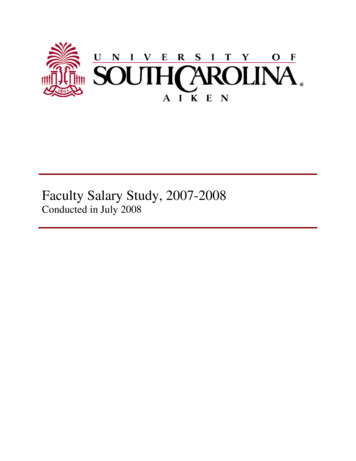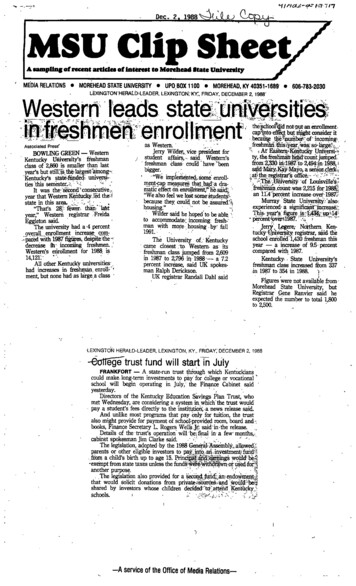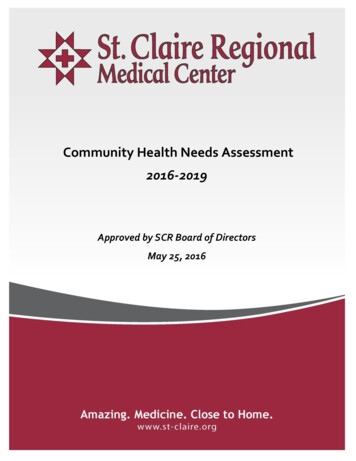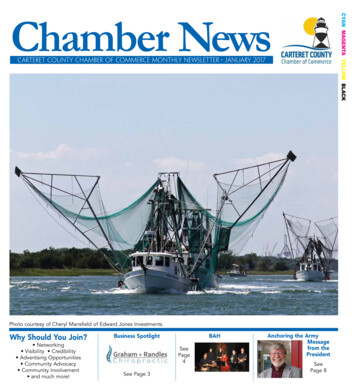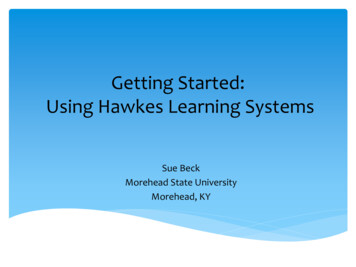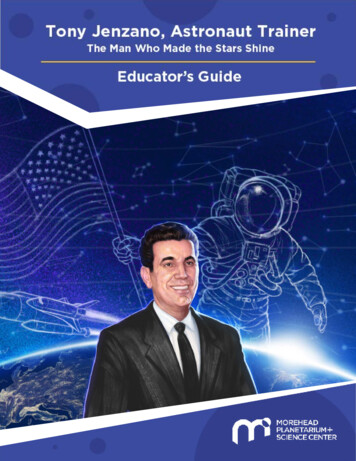
Transcription
1
Text copyright 2021 by Michael G. Neece.Illustrations copyright 2021 Benlin AlexanderAll rights reserved. This guide, or parts thereof, may not be reproduced in anyform without permission in writing from the publisher, Morehead Planetariumand Science Center, 250 E Franklin St., UNC-Chapel Hill, Chapel Hill, NC 27514.2
EDUCATOR’S GUIDETONY JENZANO, ASTRONAUT TRAINER:THE MAN WHO MADE THE STARS SHINEBY MICHAEL G. NEECE, MATILLUSTRATIONS BY BENLIN ALEXANDERMorehead Planetarium and Science Center3
CONTENTSINTRODUCTION . 1CLASSROOM ACTIVITIES & PROJECTS . 2ENGLISH LANGUAGE ARTS . 2SOCIAL STUDIES . 7SCIENCE, TECHNOLOGY, ENGINEERING, & MATH . 9VISUAL ARTS . 13CONNECTIONS TO YOUR LOCATION . 17NORTH CAROLINA ESSENTIAL STANDARDS . 19SECOND GRADE . 19THIRD GRADE . 20FOURTH GRADE . 21FIFTH GRADE . 234
INTRODUCTIONTony Jenzano, Astronaut Trainer: The Man Who Made the Stars Shine,the first children’s picture book published by Morehead Planetariumand Science Center, follows starry-eyed Tony Jenzano as he becomes anessential but hidden part of the United States space program. Illustratedin a warm, realistic style by Benlin Alexander, this little-known story beginswith the young Tony, bornthe son of Italian immigrantsin Philadelphia, and followshis adventures in the Navyand then to North Carolina,where he led MoreheadPlanetarium and taughtastronauts about stars andconstellations that helpedthem navigate in space.The book lends it-self well to a wide variety ofeducational opportunities,both in the classroom and athome. Activities and projectsin this guide address curriculum standards for grades 2–5across English language arts,STEM, social studies, and visual arts,. The book also provides a compellingstory that allows children to see possibilities for making a difference in theworld, no matter their origins.The ideas provided in this guide are meant to give you a taste of theoptions available to you. I encourage you, as a front-line educator, to askme questions, give feedback, and suggest other activities at MoreheadPublications@unc.edu.1
CLASSROOM ACTIVITIES & PROJECTSENGLISH LANGUAGE ARTSWRITE THE BOOK YOU WANT TO READChallenge your students to write a book they want to read. Useinformation in the “Advice for Writers of All Ages” and “How I Wrote TonyJenzano, Astronaut Trainer“ sections below to frame this assignment.Iterative writing process. Involve students in the iterative book-writing process by having them start writing their book at the beginning ofthe school year. After a shortperiod of research, a reasonable story can be created.Students get feedback fromyou and from a small handful of classmates, then moreresearch combined withexamination of feedbackcan lead to a first revision. Asecond round of feedbackand research can lead to asecond revision. I recommend that students spendno more than two quarters(one semester) of a schoolyear working on this project,since this can be time-consuming and student focus can wane over thecourse of projects that take multiple weeks.Group activity variation. Subset your class into groups or get thewhole class to commit to creating a single book together. Some students2
can focus on research and writing, others on illustrating, and others onbook design (exploring handmade books or desktop publishing). Thesecategories lend themselves to collaborations among science, languagearts, visual arts and technology teachers.BIOGRAPHICAL REPORTS & PROJECTSBOOK REPORT OR PRESENTATION. Ask students to summarizethe book’s depiction of Tony Jenzano, making connections to the era ofthe Space Race in American history. They can write a traditional book report or use PowerPoint, video, and posters to create a multi-media presentation about the book.READ ABOUT MORE PEOPLE IN THE SPACE RACE. Tony is just oneof the people who worked behind the scenes to make the Moon landingsa success. For a long time, many of their stories were not widely known.Now, their stories are increasingly coming to light. Invite your studentsto learn about these people, too, in biographies and autobiographies likethese: Hidden Figures: The True Story of Four Black Women and the SpaceRace, written by Margot Lee Shetterly and illustrated by Laura Freeman(Preschool–Grade 3) Margaret and the Moon: How Margaret Hamilton Saved the FirstMoon Landing, written by Dean Robbins and illustrated by Lucy Knisley(Preschool–Grade 3) When Sparks Fly: The True Story of Robert Goddard, the Father of USRocketry, written by Kristen Fulton and illustrated by Diego Funck (Preschool–Grade 3). Hidden Figures Young Readers’ Edition, written by Margot Lee Shetterly (Grades 3–7) Reaching for the Moon: The Autobiography of NASA MathematicianKatherine Johnson (Grades 5 and up)3
BACKGROUND INFORMATIONADVICE FOR WRITERS OF ALL AGES. I’ve learned four vitally important things about writing a book.1You have to care a lot about what you decide to write about. Withoutthat curiosity and interest, it can be hard to keep going when thingsget hard. If you love your subject, though, you can take breaks andget right back into it.2If you are writing a story about real events and people, ask everyonefor help. Most people want to help, and if they know they can giveyou answers, they will. People who knew Tony or who knew how tostudy history in depth pointed me to good stories, newspaper articles you name it!3Get your thoughts out on paper to start with. They won’t be perfect,they won’t be what you keep, but wrong words on a page are bet-ter than no words on a page. At least if they are the wrong ones, you’llfigure that out later as you look back at your work a few more times.4The magic of writing happens during revising. Wrong words leadto better words. Better words eventually lead to good words. Andgood words finally lead to the right words. People who read yourbook only see the final words you chose, and those are the ones youcan be proudest of, even while you remember how hard it was to getthere.When your students write, remind them that imperfections, mistakes, andmoments of frustration are all conquered in the end as long as they don’tgive up.HOW I WROTE MY BOOK. I worked at Morehead Planetarium asa college student. From 1991 to 1998, I presented simple shows and eventually gave the fully improvised constellation programs, then called “SkyRambles.” I learned to care for many of the pieces of equipment in the startheater, climbing under the flooring to lay electric wiring and climbing thesteel frame of the outside of the planetarium dome to help dust it and getit ready for painting. With all these special projects, I found myself all over4
the building, noticing pictures of astronauts lying around in the basement.My supervisor during most of that period, James Horn, mentionedTony Jenzano a few times as we discussed the star machine, special effects machines, slide projectors, and computer that I was being trained tosupport. One or two stories involved astronauts.After I graduated from UNC, I went on to work in two other planetariums and started other kinds of work as well, teaching and workingin the pharmaceutical industry. When I returned to Chapel Hill in 2007, Ibecame a part-time show presenter at Morehead, now called MoreheadPlanetarium and Science Center, giving the constellation show, now called“Carolina Skies.” Becoming more curious about Tony Jenzano and theastronauts, I searched for “the book that will tell me everything about it!”and found nothing.There were tantalizing news articles in the Chapel Hill newspapersand in UNC’s newspaper, The Daily Tar Heel. I heard more stories throughJames Horn, now retired, and Richard McColman, a mentor from my earlydays who still worked at Morehead.I realized in 2016, having never written a history book before, I wouldnevertheless have to do exactly that. I decided to write the book I reallywanted to read.Asking for help. I talked to the current director of Morehead Planetarium and Science Center, Todd Boyette, and got immediate support. Hesaid, “Whatever support I can provide, I’m happy to do. You’ll be doing theinstitution a favor to help us understand our past better and tell our ownstories.”I found out all I could from newspapers, family members of Tonyand other trainers, and even a trainer from the old days, Donald S. Hall. Ispoke with astronauts Fred Haise (Apollo 13), James Lovell (Apollo 8 andApollo 13), Charlie Duke (Apollo 16 moonwalker), Vance Brand (three-timeSpace Shuttle commander), and Story Musgrave (six-time Space Shuttlemission specialist).One of my favorite people to talk to was Carol Jenzano, Tony’sdaughter. She shared her personal archives of her dad’s letters, photographs, and files—plus a great many stories told over a meal, a coffee, or5
just over the phone.The Chapel Hill Historical Society and the Morehead Planetariumand Science Center archives both turned up many documents useful towriting a book.Writing & revising. In early 2018, I realized a children’s book wouldbe the more appropriate book to write first. While a history book was theoriginal goal, I recognized that thousands of children attended planetarium shows during field trips and many families would come for shows onweekends and holidays. Bringing a hopeful story, one specifically focusedon Tony, to children suddenly seemed vital.In January 2018, I wrote a draft of the book. I attended workshopsprovided by Susie Wilde on how to write children’s books. I consulted withother authors I knew, and spoke with my most trusted friends at the planetarium. While getting so much good advice on how to make the storybetter, I revised the book an additional six times. The final time was aftershowing the book to Carol and getting her input.6
CLASSROOM ACTIVITIES & PROJECTSSOCIAL STUDIESHISTORY OF SPACE EXPLORATIONStudents are likely to know the names and stories of some explorers—those making discoveries in space, on the Moon, and on Earth. Several twists and turns can be added to standard biography projects by usingTony Jenzano, Astronaut Trainer as a springboard to learning about spaceand the history of space exploration: Here are some of the topics that students can research and report on: Upcoming and proposed human missions to the International SpaceStation, the Moon, Mars, Europa, Alpha Centauri, and more. Minorities and women who were excluded from the astronaut ranks inthe early days. Astronauts who come from their state, whether currently training orworking as astronauts or formerly in the astronaut program. Stories of NASA flight controllers, engineers, and mathematicians working behind the scenes at NASA. Stories of less well-known astronauts from Tony Jenzano’s training era,using the list of astronauts at the back of the book as a starting point.WAX MUSEUMIn a wax museum, historical and famous people are representedby sculptures made of wax. Because wax is incredibly easy to shape andreshape as needed and holds form quite well if kept cool enough, thesefigures can look amazingly lifelike. Because wax museums held suchmystique in the public mind decades ago, people still know of them, eventhough they are quite rare in the modern world.7
Each student selects a famous or historical figure to represent, thenlearns enough about that person to pretend to be that “wax figure” at amuseum for visitors on the day of the presentation. Students can also betasked with writing informational signs and labels for their museum.IMMIGRATION & IMMIGRANTSTony Jenzano was one of ten children born to Italian immigrants living in Philadelphia, Pennsylvania. Students can: research and report on Italian immigrants in the early 1900s. research and report onfamous people, includingscientists and astronauts,who were immigrants orchildren of immigrantsand compare their experiences to Tony’s experience. Learn about patterns ofand reasons for migration in the United Statesor in the students’ ownstate or region.8
CLASSROOM ACTIVITIES & PROJECTSSCIENCE, TECHNOLOGY,ENGINEERING, & MATHPAPER CUP PLANETARIUMThe Zeiss II planetarium star projector that Tony Jenzano cared forwas an amazing device. Students can research modern star projectionsystems used in today’s museums and planetariums as one part of thisactivity, but for a hands-on component, try the following—A modern star projection system planetarium device costs as muchas a car (or a house!), but your students can create a much cheaper “PaperCup Planetarium.” This involves a small paper cup, printouts of constellations you hope to teach onpaper discs the size of themouth of the cup, a pushpinto poke holes in those discs,and an LED light poweredby a small battery. For detailed instructions andpatterns, use the CaliforniaAcademy of Sciences’ activity guide here: paper-cupplanetarium.SKYWATCHINGIn all skywatching activities, relate the importance of first-handobservations in scientific discovery, and have students keep a journal.They can note weather conditions and cloud percentage. They can make9
sketches of anything they see with the naked eye or through binoculars ora telescope. Some ways to watch the sky: Bring your students to a planetarium and request a live constellationprogram. Look for notices of local astronomy club skywatching sessions in yourarea. Either bring your students on a field trip to one of those skywatching sessions or give the information to their parents and recommend they take students. Introduce sky chart printouts and skywatching apps to your students inclass, then assign the task of locating: Sunset, giving a rough idea of where west is. Sunrise, giving a rough idea of where east is. The North Star, Polaris, possibly using a compass and star map asaids. Constellations of your choosing. (Pick prominent ones like Orionand Ursa Major first!). The Moon, noting its phase a few nights in a row or each night for amonth.KINESTHETIC ASTRONOMYBy moving around their own classroom or other open space, students can learn about Earth’s rotation and how this makes the Sun appearto rise, travel across the sky, and set. Check out this great activity, “Kinesthetic Astronomy: Earth’s Rotation,” detailed by our friends at CaliforniaAcademy of Sciences: inesthetic-astronomy-earths-rotation.SPACE MATHOur planet and the night sky above are filled with math. Here aresome ideas for using astronomy to teach math concepts.10
SCALE & PROPORTION. Our universe provides numerous fascinating celestial objects for students to compare in terms of scale and proportion: Use models or pictures of Earth, the Moon, and other Solar Systembodies (such as our Sun, Mercury, Jupiter, and other planets) to teachstudents about scale factors, proportions, and other concepts relatedto geometric shapes. NASA provides information and worksheets for the activities for Grades3-5: “The Relative Sizes of Planets and other Objects,” “Comparing Planets Orbiting other Stars,“ and “Big Moons and Small Planets“ E ZONES. Involve students in activities that explore the conceptof time as it relates to their own position on our planet (or on other planetsand the Moon): Discuss how, when, and why time zones were invented and adopted.Relate this topic to Social Studies. Help students identify which time zone they live in and ask them tofigure out the time in different parts of the United States and theworld. NASA provides information about time zones and UniversalTime here: . Ask older students to consider whether time is the same on other planets as it is on Earth. What time is it on the Moon? Consult http://lunarclock.org/ to learn about the Lunar Calendar and Lunar Standard Time. Try some of NASA’s time zone math activities for grades 3-5: https://spacemath.gsfc.nasa.gov/Grade35/5Page3.pdf and .DEGREES & DIRECTIONS. Help students learn about degrees anddirections by connecting these concepts to the students’ own position onEarth with these activities: Invite students to determine directions by using sunset, sunrise, or theNorth Star. Teach students to use a compass and observe the difference in de11
grees as they face onedirection, then another. Extend this lesson bydrawing with chalk onpavement or using colorful tape to mark theclassroom floor. Have onestudent stand with thecompass and mark theirposition at their feet.Other students can drawa large circle, perhaps 10feet in diameter, aroundthat student. As thestudent points at various stars, planets, and the moon, markings alongthat circle can be made and degree measurements can be made forvarious objects marked along that circle. The “Kinesthetic Astronomy” activity mentioned above can help students learn about degree measurements related to Earth’s rotation.Connect this to the number of hours required for one rotation (24hours), thus a rotational speed of degrees per hour.12
CLASSROOM ACTIVITIES & PROJECTSVISUAL ARTSUSING PHOTOGRAPHS AS ART REFERENCESOne way to produce realistic art—like the illustrations createdby Benlin Alexander for Tony Jenzano, Astronaut Trainer—is to refer tophotographs. Using a photograph allows an artist to refer to an imagethat doesn’t change. You can probably think of examples of real-live images that change as artists attempt to capture them on canvas or paper—someone sitting for a portrait shifts position and eventually leavesthe artist’s studio, shadows lengthen and clouds drift across a landscape,pedestrians and traffic in a cityscape hurry along. Another advantage ofphotographs is that they persist. Thus, an artist can refer to an image thatwas captured by a photographer yesterday or 100 years ago. Photography,like written words, will last a long time and allow us to experience the past.The following three activities will involve your students in considering photographs as art references.PHOTOGRAPHS OF SOLAR SYSTEM OBJECTS. NASA’s Jet Propulsion Laboratory provides resources for teaching young artists how tocreate art based on images of objects in our Solar System. Earth’s Moonand the moons of other planets are among the large collection of imagesprovided for reference. Students match geological shapes to artistic elements like line, texture, color, and value. Tips for differentiating the activityaccording to grade level are also included. You can find the “Art and theCosmic Connection” activity here: e-cosmic-connection/SELFIES & FAMILY ALBUMS. Invite students to create an artworkbased on one or more photographs from their family album or from digital photographs they have taken of themselves, an occasion, or a setting13
that is interesting or meaningful to them. A class discussion of Benlin Alexander’s artistic choices in Tony Jenzano, Astronaut Trainer (mentionedbelow) can help students begin to think about their own artistic choices.Which photograph or photographs will they select to use as reference.Which stylistic approach will they take—photo-realism, cartooning, impressionism, or another style? Will they supply color to a scene depicted ina black-and-white image, or will they change the colors in a color photograph? Will they crop the image? Will they add additional details?ARTISTIC CHOICES IN TONY JENZANO, ASTRONAUT TRAINER. Askstudents to consider how and why Benlin Alexander chose certain elements for the final illustration of astronauts in the Gemini Training Chair.When Benlin was asked to use photographs as references for producing illustrations for the book, he asked the natural question: “Are thephotographs available for that kind of use?” When proper permissionswere obtained, he was able to use the photographs in several ways to create his own illustrations.One can imagine the process of creating an illustration that nearlyduplicates the original photograph. Benlin, however, enjoyed the challenge of pulling elements from several photographs into one illustration.As an example, see the twophotographs in the handout “Picturing AstronautTraining,” which show different pairs of astronautssitting in the Gemini training chair in the planetariumtheater, then comparethem to the illustration inthe book.BACKGROUND INFORMATIONUSING OTHER PEOPLE’S PHOTOGRAPHS. Important questions offairness and respect for other artists will arise when using other people’sphotographs as references. How will the photographer, an artist who cap14
tured images with a camera, be compensated or at least consulted aboutthis use of the photograph? What if the photographer doesn’t want thephoto used in this way?Copying a photographic image by recreating it as a sketch, painting, or sculpture may not appear to be a question for ethicists. However,imagine that a second photographer took the first photographer’s imageand just snapped a photo of it. What if that second photographer scannedthe photo and edited it with software to make only minor changes, thensold copies of that edited photograph without consulting the first photographer? Clearly, this would be a form of plagiarism.More information about using photographs as references for making art can be found in “Artists and Copyright: Painting From ReferencePhotos “ here: tos-inbooks-or-field-guides-2573675.15
PICTURING ASTRONAUT TRAININGat Morehead Planetarium in North CarolinaJames Lovell and Frank Bormanin the Gemini Training ChairEd White and James McDivittin the Gemini Training ChairPhotographs courtesy of UNC Wilson Library, The North Carolina Collection (top), and NASA (bottom)16
CONNECTIONS TOYOUR LOCATIONEducators in various locations have opportunities to relate Tony Jenzano, Astronaut Trainer to their students’ local environments andresources. Here are some ideas to consider.EDUCATORS IN NORTH CAROLINA can: invite students to research and write about North Carolinians involved in space exploration (e.g., Charlie Duke, Ronald McNair, Christina Koch, and other astronauts; NASA director James E. Webb, forwhom the James Webb Space Telescope is named). discuss John Motley Morehead III (a chemist who made a fortune inbusiness) and his gift of Morehead Planetarium to North Carolina,and consider what charitable deeds they would like to do for theirown community if they had a great fortune. Would they build a planetarium or do something else? take a field trip to Morehead Planetarium and Science Center, request a school visit by Morehead’s mobile planetarium, or visit a morelocal planetarium.EDUCATORS IN PENNSYLVANIA can involve students in exploring howTony’s early story is tied to Philadelphia and his earliest planetarium workat Franklin Institute’s Fels Planetarium.EDUCATORS IN HOUSTON & LOS ANGELES can direct students to the listof astronaut training planetariums at the back of the book and researchtheir local planetarium’s astronaut training history.EDUCATORS IN THE UNITED STATES can invite students to: find out more about NASA’s early space program or about NASA’s17
current missions. learn about astronauts (from the list of sixty-two at the back of thebook) who have local connections. visit a local planetarium or science museum.EDUCATORS OUTSIDE THE U.S. can invite students to: research and write about their national space program and astronauts from their country who have worked on the InternationalSpace Station. learn about the constellations and celestial events visible in their partof the world during the year. visit a local planetarium or science museum.18
NORTH CAROLINAESSENTIAL STANDARDSSECOND GRADEENGLISH LANGUAGE ARTSRL.2.1—Ask and answer such questions as who, what, where, when,why, and how to demonstrate understanding of key details in a text.RL.2.3—Describe how characters in a story respond to major eventsand challenges.RL.2.7—Use information gained from the illustrations and words ina print or digital text to demonstrate understanding of its characters, setting, or plot.RI.2.10—By the end of grade 2, read and understand informationaltexts within the 2–3 text complexity band proficiently and independently for sustained periods of time. Connect prior knowledge andexperiences to text.W.2.5—Participate in shared research and writing projects.SL.2.2—Recount or describe key ideas or details from a text readaloud or information presented orally or through other media.SOCIAL STUDIES2.H.1—Understand how various sources provide information aboutthe past.2.H.1.1—Use timelines to show sequencing of events.2.H.1—Understand how various sources provide information aboutthe past.2.H.1.2—Identify contributions of historical figures (community,state, nation and world) through various genres.2.C&G.2—Understand the roles and responsibilities of citizens.2.C&G.2.1—Exemplify characteristics of good citizenship throughhistorical figures and everyday citizens.19
2.C&G.2—Understand the roles and responsibilities of citizens.2.C&G.2.2—Explain why it is important for citizens to participate intheir community.2.C.1—Understand how various cultures influence communities.2.C.1.3—Exemplify respect and appropriate social skills needed forworking with diverse groups.VISUAL ARTS2.V.1—Use the language of visual arts to communicate effectively.2.V.1.3—Understand the “story” in works of art.2.CX.2—Understand the interdisciplinary connections and life applications of the visual arts.2.CX.2.2—Understand relationships between art and concepts fromother disciplines, such as math, science, language arts, social studies, and other arts.THIRD GRADEENGLISH LANGUAGE ARTSRL.3.1—Ask and answer questions to demonstrate understanding ofa text, referring explicitly to the text as the basis for the answers.RL.3.3—Describe characters in a story and explain how their actionscontribute to the sequence of events.RL.3.4—Determine the meaning of words and phrases as they areused in a text, identifying words that impact the meaning in a text.RL.3.7—Explain how specific aspects of a text’s illustrations contribute to what is conveyed by the words in a story.RL.3.10—By the end of grade 3, read and understand literature atthe high end of the 2-3 text complexity band proficiently and independently for sustained periods of time. Connect prior knowledgeand experiences to text.RF.3.4—Know and apply grade-level phonics and word analysis skillsin decoding words.W.3.5—Conduct short research projects that build knowledge abouta topic.SL.3.1—Engage effectively in a range of collaborative discussions(one-on-one, in groups, and teacher-led) with diverse partners ongrade 3 topics and texts, building on others’ ideas and expressing20
their own clearly.SL.3.2—Determine the main ideas and supporting details of a textread aloud or information presented in diverse media and formats,including visually, quantitatively, and orally.SL.3.3—Ask and answer questions about information from a speaker, offering appropriate elaboration and detail.SL.3.4—Report on a topic or text, tell a story, or recount an experience with appropriate facts and relevant, descriptive details, speaking clearly in complete sentences at an understandable pace.SCIENCE3.E.1—Recognize the major components and patterns observed inthe earth/moon/sun system.3.E.1.2—Recognize that changes in the length and direction of anobject’s shadow indicate the apparent changing position of theSun during the day although the patterns of the stars in the sky, toinclude the Sun, stay the same.VISUAL ARTS3.V.2—Apply creative and critical thinking skills to artistic expression.3.V.2.3—Create art from realistic sources of inspiration.3.CX.1—Understand the global, historical, societal, and cultural contexts of the visual arts.3.CX.1.2—Understand how art documents the history of the localcommunity.3.CX.2—Understand the interdisciplinary connections and life applications of the visual arts.3.CX.2.2—Understand how to use information learned in other disciplines, such as math, science, language arts, social studies, andother arts in visual arts.FOURTH GRADEENGLISH LANGUAGE ARTSRL.4.4—Determine the meaning of words and phrases as they areused in a text, including words that affect meaning and tone.RI.4.1—Refer to details and examples in a text when explaining whatthe text says explicitly and when drawing inferences from the text.21
RI.4.2—Determine the main idea of a text and explain how it is supported by key details; summarize the text.RI.4.3—Explain events, procedures, ideas, or concepts in a historical, scientific, or technical text, including what happened and why,based on specific information in the text.RI.4.5—Describe the overall structure of events, ideas, concepts, orinformation in a text or part of a text.RI.4.7—Interpret information presented visually, orally, or quantitatively and explain how the information contributes to an understanding of the text in which it appears.RI.4.8—Explain how an author uses reasons and evidence to support particular points in a text.W.4.5—Conduct short research projects that build knowledgethrough investigation of different aspects of a topic.SL.4.1—Engage effectively in a range of collaborative discussions(one-on-one, in groups, and teacher-led) with diverse partners ongrade 4 topics and texts, building on others’ ideas and expressingtheir own clearly.SL.4.2—Paraphrase portions of a text read aloud or informationpresented in diverse media and formats, including visually, quantitatively, and orally.SL.4.4—Report on a topic or text, tell a story, or recount an experience in an organized manner, using appropriate facts and relevant,descriptive details to support main ideas or themes; adjust speechas appropriate to formal and informal discourse.VISUAL ARTS4.V.2—Apply creative and critical thinking skills to artistic expression.4.V.2.2—Use ideas and imagery from
Moon Landing, written by Dean Robbins and illustrated by Lucy Knisley (Preschool-Grade 3) When Sparks Fly: The True Story of Robert Goddard, the Father of US Rocketry, written by Kristen Fulton and illustrated by Diego Funck (Pre-school-Grade 3). Hidden Figures Young Readers' Edition, written by Margot Lee Shet-terly (Grades 3-7)
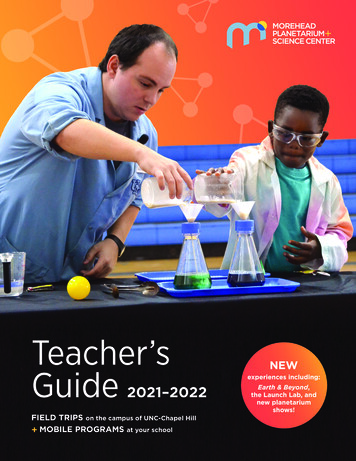
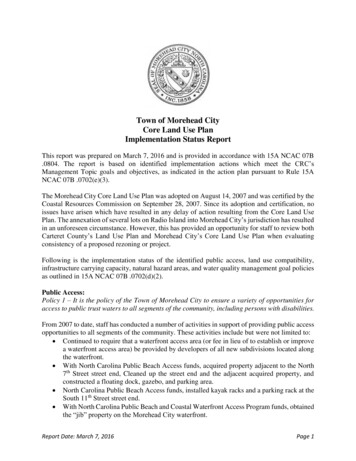
![Welcome [ uky.edu]](/img/13/morehead-20catalog-20s19.jpg)
